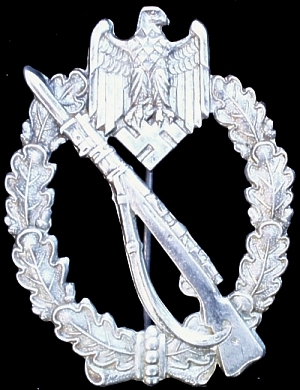
By Sebastián Bianchi
he Infantry Combat Badge, more commonly referred to as the Infantry Assault Badge, was designed by C. E. Junker of Berlin and instituted on December 20, 1939 by Generaloberst von Brauchitsch. The initial class was instituted in silver and decorated foot infantry who participated in combat action earning a degree of experience that qualified them for the badge.
A separate class, in Bronze, was instituted on June 1, 1940. The Bronzed class had criteria similar to the requirements the Silver. There was, however, one notable distinction; The status of the troops, bronzed meant motorized Panzer troops, silver meant foot infantry.


S. Bianchi Collection
Manufacturing and Technical information
The Infantry Assault Badge consists of an oval wreath of oak leaves, made up of four leaves on each side of the arch. Every oak leaf has two acorns, one on each side of the base of the leaf. Centered at the bottom of the badge is a ribbon tied around the wreath, with five raised pellets in a vertical position at the center of this ribbon. The Badges most distinguishable feature is the K98 rifle positioned diagonally across award. The butt of this rifle, positioned on the right, is slightly below the wreath. It leans to the left, with its fixed bayonet protruding through the last of the four oak leaves. The rifle sling forms a loop, hanging from the stock to the butt. Surmounting the wreath is the national emblem; an eagle with down swept wings clutching a swastika in its talons. The badge has intricate detailing from the eagle down to the bolt on the rifle.


S. Bianchi Collection
The Infantry Assault Badge measures 46mm across and was slightly convex with either a solid or hollow back, and could be die stamped or cast. The reverse had a vertical pin with a hinge that was attached to the back of the eagle, with a retaining "C" clip which retained the clip. The method of attachment for the clip varied, some were welded or soldered while others had a more elaborate scheme where the pin sits in a recessed location the edges of which are crimped in order to hold the hinge in place (pictured above in the Bronzed version).
Though the majority of Infantry Assault Badges are unmarked, manufacturer marked pieces are often found. Below is a list of manufacturers that have been determined to be genuine makers of this badge,
| FZS | Fritz Zimmerman und Sohne, Ludenscheid |
| BSW | Gebruder Schweiger, Wien |
| S.H.u.Co. | Sohni, Heubach & Co |
| WH | Walter & Henlein |
| JFS | Josef Feix Sohne Gablonz |
| A | Assmann und Sohne, Ludenscheid |
| C.W. | Carl Wilde, Hamburg |
| R.S.S. | Richard Simm & Sohne, Gablonz |
| R.S. | Rudolf Souval, Wein |
| F.O. | Freidrich Orth, Wein |
| WH | Hermann Wernstein, Jena-Lobstadt |
| F.L.L. | Friedrich Linden, Ludenscheid |
| C.E. | Junker, Berlin |
| AS | Adolf Schilze, Grunwald |
| H.A. | Hermann Aurich, Dresden |
| GWL | Gerbruder Weger, Ludenscheid |
The award was also available in a lapel pin miniature version to be worn whilst in civilian clothing.
Due to the many different makers of this badge, it is not unusual to find slight differences between them. Early Infantry Assault badges that where stamped had a heavy plating of the correct finish applied to them. As the new restrictions came into effect and the lower quality metals were used, a silver or Bronze "wash" was applied to the badge, which did not take long to wear off leaving the grayish metal exposed. For a more detailed study of the subject please visit the Badges Construction Techniques page.
Presentation, Wear and Documents
Both Infantry Assault Badges were awarded in recognition of combat action. Authorized through the regiment commander, awards of the Infantry Assault Badge were made on the field and issued with an award document. This award document was of the standard type and included information on the recipient, such as date, unit and name but as with most Third Reich documents no mention of the merit that earned the badge. The award itself came in a brown paper envelope with the name of the award printed on it. As with most war badges, it was worn on the left breast pocket. There was no provision for the Badge to be worn on the gray coat
Award Criteria
The silver Infantry Assault Badge was awarded to enlisted men, officers, NCO's of rifle companies (not in Motorized Infantry Divisions) and Mountain Troop companies. As mentioned above on June 1, 1940, the Bronze Infantry Assault Badge was instituted for Motorized Infantry regiments. To view the story of a recipient, please see the Rudolph HillebrandAward criteria was as follows:
SILVER AWARD:
- To have taken part in three or more infantry assaults.
- To have taken part in three or more infantry counter-attacks.
- To have taken part in three or more armed reconnaissance operations.
- To have engaged in hand to hand combat in an assault position.
- To have participated on three separate days in the restitution of combat positions.
BRONZE AWARD:
- To have taken part in three or more motorized infantry assaults.
- To have taken part in three or more motorized infantry counter-attacks.
- To have taken part in three or more motorized armed reconnaissance operations.
- To have been engaged in hand to hand combat in motorized assault positions.
- To have participated on three separate days, in the restitution of a motorized combat position.
The attacks had to take place on different days, in the event that they took place on one day only one "credit" was earned.

|
Infantry Assault Reciepient Oberst Heinz-Oskar Laebe of GR.Rgt.44. Received the Knights Cross on March 7, 1944, and Oakleaves on April 29, 1945. |
![]()
© Copyright Wehrmacht-Awards.com LLC |